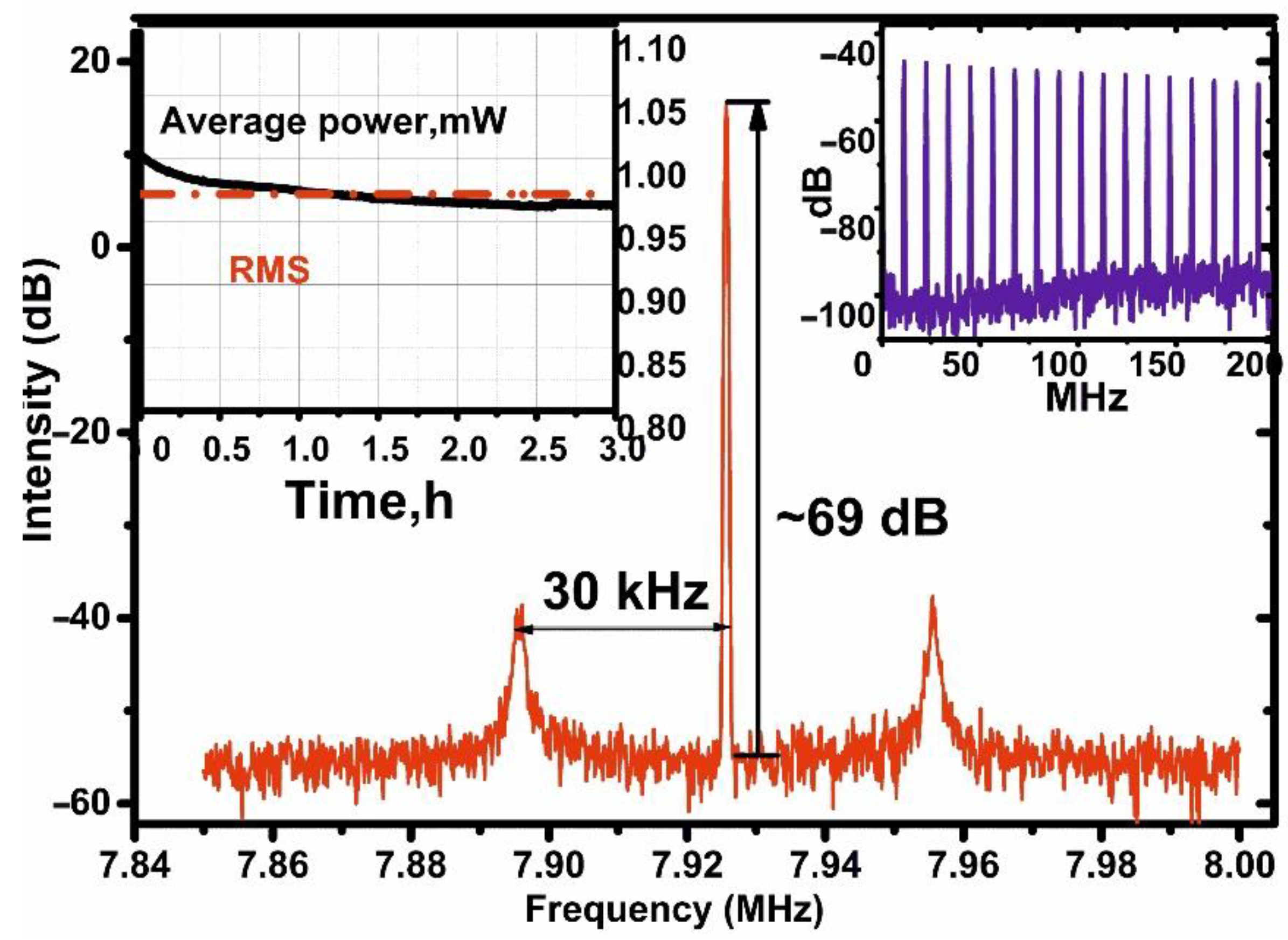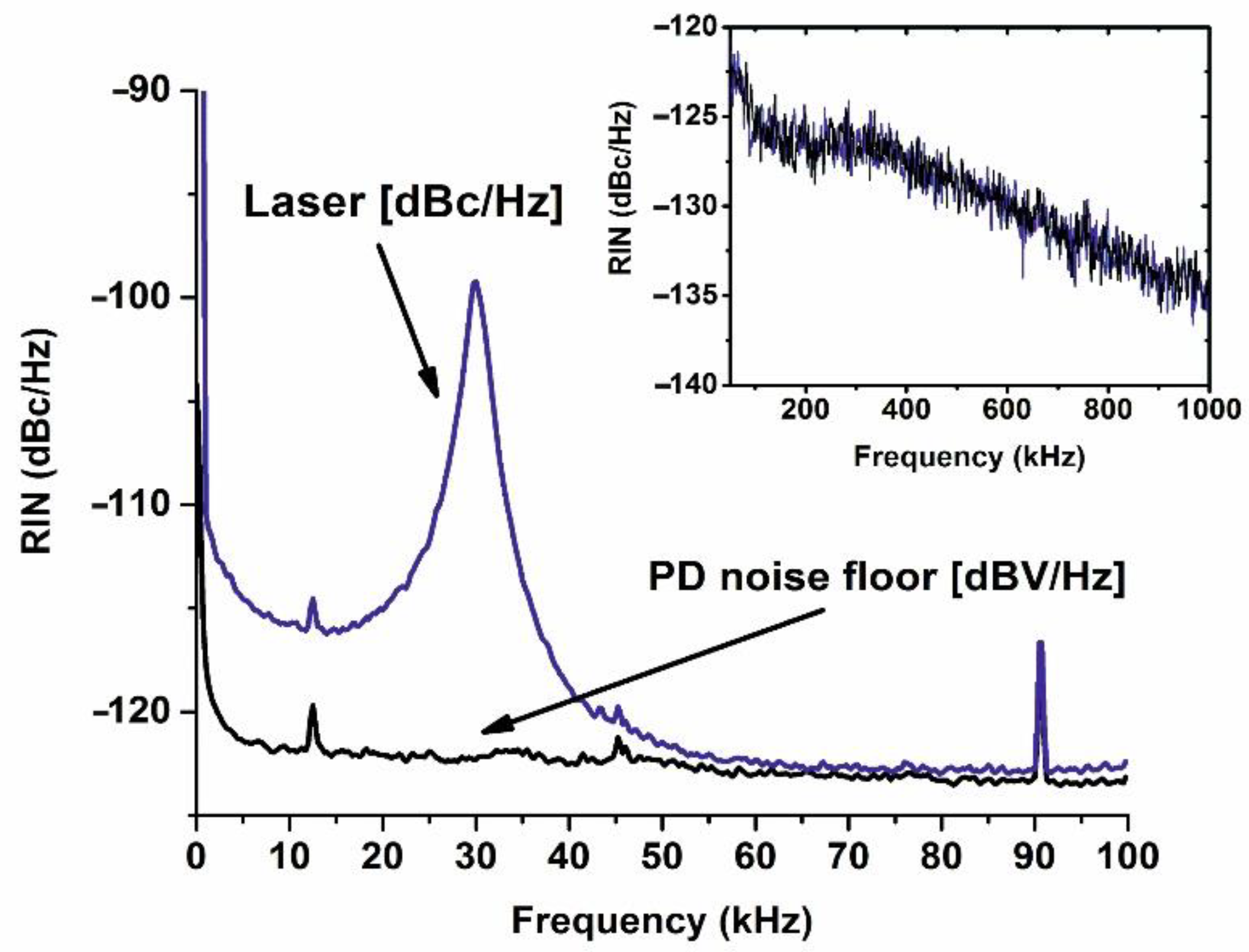Properties of Scalable Chirped-Pulse Optical Comb in Erbium-Doped Ultrafast All-Fiber Ring Laser
Abstract
:1. Introduction
2. Materials and Methods
3. Experimental Results and Discussion
4. Conclusions
Author Contributions
Funding
Institutional Review Board Statement
Informed Consent Statement
Data Availability Statement
Conflicts of Interest
References
- Fermann, E.; Hartl, I. Ultrafast fibre lasers. Nat. Photonics 2013, 7, 868–874. [Google Scholar] [CrossRef]
- Crotti, C.; Deloison, F.; Alahyane, F.; Aptel, F.; Kowalczuk, L.; Legeais, J.-M.; Peyrot, D.A.; Savoldelli, M.; Plamann, K. Wavelength optimization in femtosecond laser corneal surgery. Investig. Ophthalmol. Vis. Sci. 2013, n54, 3340–3349. [Google Scholar] [CrossRef]
- Plamann, K.; Aptel, F.; Arnold, C.L.; Courjaud, A.; Crotti, C.; Deloison, F.; Druon, F.; Georges, P.; Hanna, M.; Legeais, J.-M.; et al. Ultrashort pulse laser surgery of the cornea and the sclera. J. Opt. 2010, 12, 084002. [Google Scholar] [CrossRef]
- Malinauskas, M.; Žukauskas, A.; Hasegawa, S.; Hayasaki, Y.; Mizeikis, V.; Buividas, R.; Juodkazis, S. Ultrafast laser processing of materials: From science to industry. Light. Sci. Appl. 2016, 5, e16133. [Google Scholar] [CrossRef] [PubMed] [Green Version]
- Gattass, R.; Mazur, E. Femtosecond laser micromachining in transparent materials. Nat. Photonics 2008, 2, 219–225. [Google Scholar] [CrossRef]
- Pavlova, S.; Rezaei, H.; Pavlov, I.; Kalaycıoğlu, H.; Ilday, F. Generation of 2-μJ 410-fs pulses from a single-mode chirped-pulse fiber laser operating at 1550 nm. Appl. Phys. A 2018, 124, 201. [Google Scholar] [CrossRef]
- Grelu, P.; Akhmediev, N. Dissipative solitons for mode-locked lasers. Nat. Photonics 2012, 6, 84–92. [Google Scholar] [CrossRef]
- Han, Y.; Jalali, B. Photonic time-stretched analog-to-digital converter: Fundamental concepts and practical considerations. J. Lightwave Technol. 2003, 21, 3085. [Google Scholar] [CrossRef] [Green Version]
- Tsia, K.K.; Goda, K.; Capewell, D.; Jalali, B. Performance of serial time-encoded amplified microscope. Opt. Express 2010, 18, 10016–10028. [Google Scholar] [CrossRef] [Green Version]
- Wang, H.; Kotov, L.V.; Gaponov, D.A.; Cabasse, A.; Yashkov, M.V.; Lipatov, D.S.; Likhachev, M.E.; Oudar, J.-L.; Martel, G.; Février, S.; et al. Dissipative Soliton Generation and Amplification in Erbium-Doped Fibers Operating at 1.55 μm. IEEE J. Sel. Top. Quantum. Electron. 2014, 20, 283–289. [Google Scholar] [CrossRef]
- Sobon, G.; Kaczmarek, P.R.; (Sliwinska), D.S.; Sotor, J.; Abramski, K.M. High-Power Fiber-Based Femtosecond CPA System at 1560 nm. IEEE J. Sel. Top. Quantum. Electron. 2014, 20, 492–496. [Google Scholar] [CrossRef]
- Tang, M.; Granger, G.; Lesparre, F.; Wang, H.; Qian, K.; Lecaplain, C.; Oudar, J.-L.; Jaouen, Y.; Gabet, R.; Gaponov, D.; et al. Large Normal Dispersion Mode-Locked Erbium-Doped Fiber Laser. Fibers 2019, 7, 97. [Google Scholar] [CrossRef] [Green Version]
- Dai, W.; Song, Y.; Xu, B.; Martinez, A.; Yamashita, S.; Hu, M.; Wang, C. High-power subpicosecond all-fiber laser source at 1.56 μm. Chin. Opt. Lett. 2014, 12, 111402. [Google Scholar]
- Khegai, A.; Melkumov, M.; Riumkin, K.; Khopin, V.; Firstov, S.; Dianov, E. NALM-based bismuth-doped fiber laser at 17 μm. Opt. Lett. 2018, 43, 1127–1130. [Google Scholar] [CrossRef] [PubMed]
- Arutyunyan, N.R.; Arenal, R.; Obraztsova, E.D.; Stephan, O.; Loiseau, A.; Pozharov, A.S.; Grebenyukov, V.V. Incorporation of boron and nitrogen in carbon nanomaterials and its influence on their structure and opto-electronical properties. Carbon 2012, 50, 791–799. [Google Scholar] [CrossRef]
- Krylov, A.A.; Sazonkin, S.G.; Arutyunyan, N.R.; Grebenyukov, V.V.; Pozharov, A.S.; Dvoretskiy, D.A.; Obraztsova, E.D.; Dianov, E.M. Performance peculiarities of carbon-nanotube-based thin-film saturable absorbers for erbium fiber laser mode-locking. JOSA B 2016, 33, 134–142. [Google Scholar] [CrossRef]
- Wang, Y.; Alam, S.U.; Obraztsova, E.D.; Pozharov, A.S.; Set, S.Y.; Yamashita, S. Generation of stretched pulses and dissipative solitons at 2 μm from an all-fiber mode-locked laser using carbon nanotube saturable absorbers. Opt. Lett. 2016, 41, 3864–3867. [Google Scholar] [CrossRef] [PubMed] [Green Version]
- Liu, X.M.; Duan, L.N.; Mao, D.; Wang, L.R. Evolution of dissipative-soliton laser from molecule to multipulse. Laser Phys. 2011, 21, 1085–1091. [Google Scholar] [CrossRef]
- Duan, L.N.; Li, L.; Wang, Y.G.; Wang, X. All-fiber dissipative soliton laser based on single-walled carbon nanotube absorber in normal dispersion regime. Optik 2017, 137, 308–312. [Google Scholar] [CrossRef]
- Dvoretskiy, D.A.; Sazonkin, S.G.; Orekhov, I.O.; Kudelin, I.S.; Pnev, A.B.; Karasik, V.E.; Krylov, A.A.; Denisov, L.K. High-energy ultrashort-pulse all-fiber erbium-doped ring laser with improved free-running performance. J. Opt. Soc. Am. B 2018, 35, 2010–2014. [Google Scholar] [CrossRef]
- Kieu, K.; Wise, F.W. All-fiber normal-dispersion femtosecond laser. Opt. Express 2008, 16, 11453–11458. [Google Scholar] [CrossRef] [PubMed] [Green Version]
- Nishizawa, N.; Nozaki, Y.; Itoga, E.; Kataura, H.; Sakakibara, Y. Dispersion-managed, high-power, Er-doped ultrashort-pulse fiber laser using carbon-nanotube polyimide film. Opt. Express 2011, 19, 21874–21879. [Google Scholar] [CrossRef] [PubMed]
- Agrawal, G. Nonlinear Fiber Optics, 5th ed.; Academic Press: Boston, MA, USA, 2012. [Google Scholar]




Publisher’s Note: MDPI stays neutral with regard to jurisdictional claims in published maps and institutional affiliations. |
© 2021 by the authors. Licensee MDPI, Basel, Switzerland. This article is an open access article distributed under the terms and conditions of the Creative Commons Attribution (CC BY) license (https://creativecommons.org/licenses/by/4.0/).
Share and Cite
Orekhov, I.O.; Dvoretskiy, D.A.; Sazonkin, S.G.; Ososkov, Y.Z.; Chernutsky, A.O.; Fedorenko, A.Y.; Denisov, L.K.; Karasik, V.E. Properties of Scalable Chirped-Pulse Optical Comb in Erbium-Doped Ultrafast All-Fiber Ring Laser. Fibers 2021, 9, 36. https://doi.org/10.3390/fib9060036
Orekhov IO, Dvoretskiy DA, Sazonkin SG, Ososkov YZ, Chernutsky AO, Fedorenko AY, Denisov LK, Karasik VE. Properties of Scalable Chirped-Pulse Optical Comb in Erbium-Doped Ultrafast All-Fiber Ring Laser. Fibers. 2021; 9(6):36. https://doi.org/10.3390/fib9060036
Chicago/Turabian StyleOrekhov, Ilya O., Dmitriy A. Dvoretskiy, Stanislav G. Sazonkin, Yan Z. Ososkov, Anton O. Chernutsky, Aleksander Y. Fedorenko, Lev K. Denisov, and Valeriy E. Karasik. 2021. "Properties of Scalable Chirped-Pulse Optical Comb in Erbium-Doped Ultrafast All-Fiber Ring Laser" Fibers 9, no. 6: 36. https://doi.org/10.3390/fib9060036
APA StyleOrekhov, I. O., Dvoretskiy, D. A., Sazonkin, S. G., Ososkov, Y. Z., Chernutsky, A. O., Fedorenko, A. Y., Denisov, L. K., & Karasik, V. E. (2021). Properties of Scalable Chirped-Pulse Optical Comb in Erbium-Doped Ultrafast All-Fiber Ring Laser. Fibers, 9(6), 36. https://doi.org/10.3390/fib9060036








